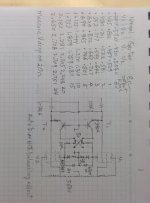dgta,
The idea to use different tubes, and/or maybe 2 on one side, and one on the other is a good idea.
However, my idea was to show how two tubes of the same type that were not purposely matched would perform in both a Garter Bias circuit, and then how well they would perform with individual self bias.
But using 2 different types, and/or 2:1 tubes does not prove the concept.
That is not the same as two Real 6L6 tubes, of different manufacturers, vintage, etc.
I bet there might be some who are surprised if they started with push pull and Fixed Adjustable Bias, and then converted to Individual Self Bias, and raised the B+ by the amount of the Bias voltage.
The Self Bias balances fairly well, without any adjustment.
And . . . as the tubes age, the balance continues.
Simulate it, and remember it for a week.
Build it, and remember it for a lifetime.
I do not remember the person who did the question and then the answer in the next issue.
I am getting old.
The idea to use different tubes, and/or maybe 2 on one side, and one on the other is a good idea.
However, my idea was to show how two tubes of the same type that were not purposely matched would perform in both a Garter Bias circuit, and then how well they would perform with individual self bias.
But using 2 different types, and/or 2:1 tubes does not prove the concept.
That is not the same as two Real 6L6 tubes, of different manufacturers, vintage, etc.
I bet there might be some who are surprised if they started with push pull and Fixed Adjustable Bias, and then converted to Individual Self Bias, and raised the B+ by the amount of the Bias voltage.
The Self Bias balances fairly well, without any adjustment.
And . . . as the tubes age, the balance continues.
Simulate it, and remember it for a week.
Build it, and remember it for a lifetime.
I do not remember the person who did the question and then the answer in the next issue.
I am getting old.
Last edited:
Wouldn't just paralleling a resistor between cathode and plate of one tube be an easy way to start with?How do you simulate two 6L6 tubes that are badly matched?
Best regards!
No I don't think it would. A fixed shunt is not a good representation of anything that would normally occur to a tube except perhaps total failure.
Kay Pirinha,
A resistor generally is linear (until it is run so hot that its resistance changes, or even smokes).
A tube is dynamically changing.
rp, u, Gm change as the voltages and currents change.
A resistor generally is linear (until it is run so hot that its resistance changes, or even smokes).
A tube is dynamically changing.
rp, u, Gm change as the voltages and currents change.
Agreed. But let's not get carried away. We're not trying to devise a scheme to make an imperfect situation perfect under all dynamic circumstances. All we're trying to do is devise a scheme that will re-establish dc balance. Hopefully at the original intended bias point.
So it wouldn't be a great effort to change one tube model to a lower gm or higher ra or both. But I found Broskie's method (2 tubes in parallel) quite sufficient to see if and how well a balancing scheme works.
So it wouldn't be a great effort to change one tube model to a lower gm or higher ra or both. But I found Broskie's method (2 tubes in parallel) quite sufficient to see if and how well a balancing scheme works.
Isn’t this one of those discussions where different goals get conflated, so the proposed solutions always fail one test? For instance, there are the problems of matching tubes, then keeping them matched, then also protecting the amplifier from a tube in terminal decline.
Cathode bias goes a long way to solving all 3, but is a compromise too far for anyone who wants a fixed bias solution.
As Confucius say, ‘a problem this hard have more than one solution’.
I like the reading work of Patrick Turner, and his thinking is to make setting the balanced bias straightforward, and also providing active bias protection, so that a gross imbalance, caused if a tube starts to run away, triggers a fail safe, and turns off the power with a visible warning.
I intend to build a solution like this for a PP EL34 amp I have that just has one balance pot inside the amp for 4 tubes.
Cathode bias goes a long way to solving all 3, but is a compromise too far for anyone who wants a fixed bias solution.
As Confucius say, ‘a problem this hard have more than one solution’.
I like the reading work of Patrick Turner, and his thinking is to make setting the balanced bias straightforward, and also providing active bias protection, so that a gross imbalance, caused if a tube starts to run away, triggers a fail safe, and turns off the power with a visible warning.
I intend to build a solution like this for a PP EL34 amp I have that just has one balance pot inside the amp for 4 tubes.
FYI, I solder a toggle switch to see the V1 and V2 cathode current different between normal and Garter hook up. I set the V1 idle current to 20 ma and V2 was 29.6 ma. I run the output from 1V to 24V at 8 ohm load. It looks the Garter circuit help improved V1 and V2 balanced.
Attachments
- Home
- Amplifiers
- Tubes / Valves
- 75 watt ultra linear power amp
